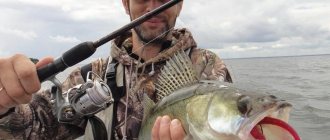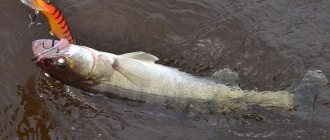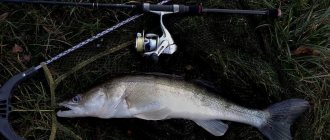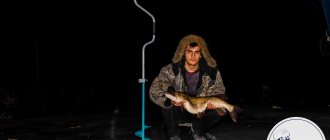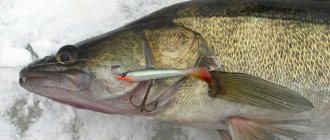The moon is an assistant to a good spinning player
Catching pike-perch at night
As practice has shown, night-time pike-perch fishing can often be more productive than daytime or morning fishing. This predator is especially voracious during the full moon (5 days before and 5 days after).
As the water temperature drops, the “fanged” one begins to hunt at shallow depths (up to 2.5 meters). There he is caught using a wide variety of wobblers. At the same time, it is not at all necessary that they copy living fish one to one. The main thing is that the baits are larger, longer and have “eyes” on which the pike perch concentrates its blow.
Weather for autumn fanged fishing
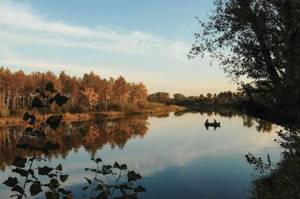
On a warm autumn day you can meet him in the late afternoon. Autumn weather is often capricious: calm, wind, lunar phases and atmospheric phenomena. These factors directly affect the behavior of the fanged animal and its activity. With the advent of cloudiness, in the absence of strong wind and precipitation, the activity of the predator increases. The chances of catching a test specimen increase at night as the full moon approaches.
Note! The chances of getting a trophy increase in the period of five to six days before and after the full moon.
At what pressure does pike perch bite best in autumn?
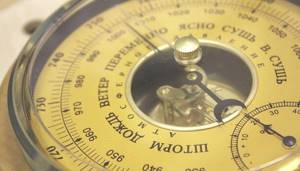
When pressure decreases, fish activity decreases several times. There is virtually no chance of catching a predator before a storm. The cyclone forces the fish to lie low and wait out this unfavorable period.
High pressure saturates the water with oxygen. This helps the fish breathe easier and has more strength to move. At this time, the pike perch has an excellent appetite.
Influence of wind and precipitation
Experienced spinning anglers know that when there is wind, a fanged fish is drawn to the shore like a magnet. It's simple: the wind, washing the coastal edge, creates foam and turbidity, and washes away food. The most important point is the formation of an edge (border) of muddy and clear water.
We recommend reading: Winter pike fishing with girders
On a note! With a stable strong wind, pike perch always leaves the holes and tends to the shore. The fry also move to the shoreline in hopes of getting food.
The long-awaited “meeting on the Elbe” takes place between the attacking predator and the potential victim, the fry. Such places are often “shelled” when catching fanged fish with a spinning rod from the shore.
The steeper the cliff, the larger the pike perch
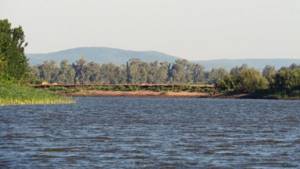
If you are lucky enough to find a deep edge not far from the shore, then be sure to stay longer on it. It is here that there is a high probability that pike perch will ambush small fish passing by.
To successfully catch “fanged” fish, take a jig head weighing 10 g and a twister or vibrotail from 7 to 10 cm long. They try to lead the bait so that it “knocks” on the bottom right in front of the nose of the lurking predator. Naturally, such impudence will not go unnoticed by the pike perch, and it will certainly attack. And the greater the depth difference, the better.
You can catch pike perch here not only with jigs, but also with diving wobblers. The “fanged one” will also bite well on live bait - a worm, a leech, and live bait. A piece of caught fish in the form of a strip (peritoneum), planted instead of silicone bait, can catch better than any edible rubber.
Wires for catching pike perch
It’s easier to catch pike perch if you choose the right bait for the bait and the mood of the fish. On deep-water edges, fishing is carried out more often with the help of a jig, and on the adjacent shallows, mainly using wobblers. Let’s try to figure out further what fishing for which bait will be the best... Let’s look at the peculiarities of fishing for pike perch in river conditions with the usual difficulties - windbreaks along the shore, significant currents in deep, cluttered places. This kind of fishing for pike perch is of particular interest, because there are many good places for pike perch in these conditions, all that remains is to create suitable gear, and then use it correctly, including choosing the wiring.
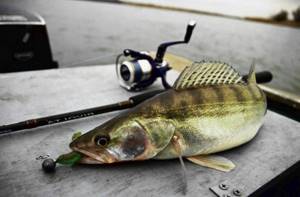
Active pike perch in autumn
In autumn, pike perch are more often active, greedy for their victims, and take the bait with a gulp, so they are detected more reliably. In the fall, an actively moving bait is better suited for pike perch. To do this, it is recommended to use a slightly overloaded jig. Then you can make powerful, clear vertical throws on the step, as well as knocking on the bottom, which this predator undoubtedly likes when it fishes itself.
For fattening pike perch in the fall, high-speed retrieves are better suited, because now the fish are able to catch up and attack the bait, and fast movement causes more irritation, for example:
- 2 - 3 turns with the reel handle and a pause until the tip returns to its original position, the cycle is immediately repeated - again 2 - 3 quick turns...
In summer
Summer pike perch is usually moderately active, with the best bite at dawn, and not bad at night. During the day, it is more promising to look for it on deep-sea edges from 3 meters, and in the morning and evening on the adjacent shallows and dunes, where it rises and noisily chases the fry. In shallow water, wobblers are more interesting for shallow, stable depths and night fishing. But at depth - a classic jig with a load of 20 - 23 grams.
In summer, as opposed to autumn, it is more advisable to use complex wiring designed to provoke fish, which we will consider further
Posting for pike perch in summer
Several zander lines for summer fishing, for hinged mounting with an offset machine with a load of about 20 grams. The choice of slack after jerking is done by the reel.
- normal wiring - 2 - 3 turns of the coil and a pause;
- tossing the bait, then a short pull along the bottom up to 15 cm, a short pause and repeat...;
- a couple of tosses of the bait with a rod, then a short pause, again tosses, another pause - then stretching up to half a meter along the bottom with a toss - after a pause of 10 seconds, the cycle is repeated again;
- 2 jerks in a row, after a second 1 jerk, a smooth pull along the bottom with the coil, then a pause of several seconds and the process is repeated again.
Where is the largest pike perch caught?
The largest pike perch for a given area will typically be at depths of 5 - 8 meters, behind a single but significant cover. This is a trunk, a boulder, a hole, a support, perhaps a bunch of silted snags at the bottom... If such a place is found on a pike-perch river, then sooner or later it will yield a trophy fish. Particularly good are the places where there is also a shadow of the current from the hillocks or others in front. Then the pike perch does not strain behind its cover, i.e. will be there permanently.
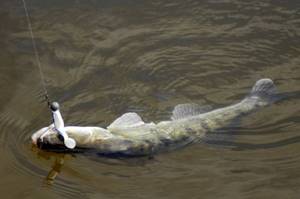
Fishing in spring
In the spring, the current on the rivers is powerful, the water is muddy, so in the channel depression, on the deep-water edges - a typical place for summer and autumn fishing, it is unlikely that you will be able to meet and catch pike perch. Usually, even a load of 50 grams is carried away by the flow, skipping without control, so it is not even possible to create sane attractiveness with a jig on spring streams. But on the other hand, reverse currents at turns, snags on the banks, edges under the shore - places where you can usually fish with a load of up to 30 grams - help out.
Spring fishing for pike perch in the indicated quiet places of the river can be done without any special frills, just to achieve clarity in choppy water.
Wiring for pike perch in spring:
- two turns and a pause - without experimentation, then it will be more difficult to miss a bite with a taut cord and a controlled bait.
It is better to stand above the area being fished and cast against the current at an angle. Any suspicious incident with bait in high flows should be taken as a bite and hooked. Pike perch is not as active as during the autumn feeding season, so it can take it softly.
Regarding gear
- For jigging in the shallows, it is better to use relatively short but powerful bass series spinning rods, about 2.0 meters long. They detect better and more clearly control the bait at short distances.
- For regular fishing for pike perch at depth, for active fishing in the fall, choose a fast action 2.2 - 2.4 meters long and a reel size 4000.
- It makes no sense to use a thin cord, since shell rock found everywhere, including on flooded trunks, around which pike perch are found, will not give life. 20lb or more is the recommended cord to reduce problems.
- An important detail is the leash in the pike perch rig. Many fishermen assume that there will be pike, and therefore install pike leashes, which slow down the entire tackle. Regarding this, there are authoritative opinions that it is better to lose the bait occasionally from a pike attack than to miss bites from pike perch on rough tackle. Many experienced fishermen are guided by this and do not use any leashes not designed for pike perch.
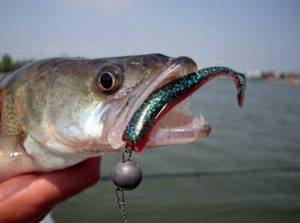
Successful fishing for pike perch will not be possible without a set of modern jig baits, preferably from different manufacturers. The chassis are narrow-bodied and of medium length...
Wiring direction
A typical mistake is possible - constant repetition of movements in one direction relative to the stream of water, hence some monotony of the game and speed of movement, and therefore the sound of the bait under water. As a result, many reserves built into the gear are not used. You should change the direction of casting - across the current, at an angle, against the current. It is not uncommon for demolition wiring to become catchy. Somehow you need to achieve better animation of the bait, adapting to the strength and direction of specific jets. It is important to take into account that the speed of movement relative to the water, and therefore the noise of the wiring, and possibly the rise of turbidity, will be different for new directions, and the pike perch will definitely like which of the options.
Fishing with bottom bouncer (ballerina)
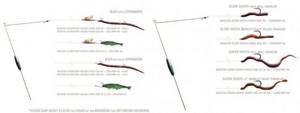
Our American colleagues successfully fish with a bottom bouncer rig, which is an L-shaped rocker made of wire with an olive weight attached to the long end (its weight depends on the depth - there should be at least 10 g for each meter). In our country, such equipment is called “ballerina”.
A leash with a hook or bait at the end is tied to the short end of the rig. Bait: large crawler, leech, small fish. It is advisable that the angle between the fishing line and the water when fishing is about 40 degrees, otherwise there may be many empty bites.
When the pike perch is sufficiently active, natural bait in the bottom bouncer rig is successfully replaced with artificial bait. This could be a silicone worm or twister, a small spinner, or a combination of both. For example, a spinner + a large natural worm on a hook.
Autumn is the time for fast wiring
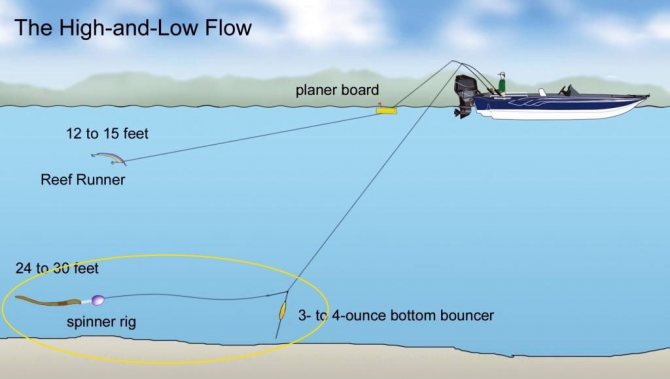
The colder the autumn water becomes, the more intense the retrieve should be. Especially when catching pike perch by trolling. It is advisable to accelerate your vessel to a speed of 3-3.5 km/h. In addition, at high speed you can fish a significant area of water and quickly find a hidden predator.
Spinning rod equipment for pike perch
To catch pike perch, select a spinning rod with a fast or ultra-fast action. Rigidity ensures a sharp strike, allowing you to reliably pierce the strong jaw of a predator. When fishing from the shore, you will need a rod about 3 meters long, and from a boat it is convenient to fish with a 2.4 m model.
High-quality spinning reels and inertial models are suitable.
A spinning cord is used that can withstand a load of 7 kilograms or more. If a fishing line is used, it must be of the same load capacity. It is advisable to tie a leash made of fluorocarbon fishing line. Care should be taken to quickly replace the leash. During the fishing process, you need to monitor its condition. Frequent contact with stones during wiring can cause the appearance of burrs and, accordingly, a decrease in load capacity.
Jig spinners
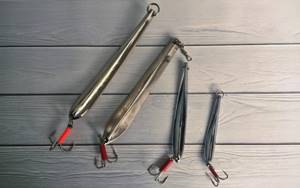
Jig spoons are one of the types of baits for vertical spinners. These could be jigs of suitable weight, some other vertical-type spoons, or even winter balancers.
Stand on a boat over a school of walleye and start pissing it off with a moving bait. A spinner gliding up and down will certainly be caught by a predator, who will not be able to remain indifferent for long to the nimble “fish” that has decided to frolic near its ambush site.
Thickets of underwater vegetation
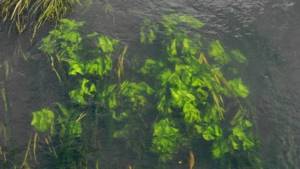
In autumn, most of the algae die and sink to the bottom, scaring away picky fish with their unpresentable appearance and smell. However, this does not apply to all vegetation. Some types of algae can live until late autumn.
For example, green algae with wide leaves. Next to them, you can successfully catch pike perch using a float rod with a leech as bait or using wobblers.
Video
Autumn fishing for pike perch on a jig video
Excellent Cool. Worthy Catch! Video from “Fishing with Romario Agro”
Features of catching pike perch in late autumn video
Pike perch has always been a desirable trophy for any angler. Volga pike perch in the Samara region remains active almost all year round, but catching it is not as easy as it might seem at first glance. Autumn is undoubtedly the best time to hunt pike perch, which begins to feed around the end of October.
Rocky reefs are a stopover for large pike perch
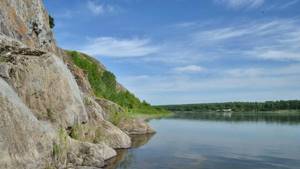
It is worth looking for trophy specimens of the “fanged one” in the area of rocky reefs, at great and medium depths. At half-water you can fish with wobblers, and from the bottom - with a jig head with a crawler on the hook. The wiring is stepped, with tapping on the bottom.
It happens that the worm is eaten by annoying gobies, who also like to hang around among the stones. In this case, it is advisable to attach a dark-colored wobbler instead of a jig and as similar to a bull as possible. Most likely, the pike perch here is accustomed to hunting it.
Farewell to summer. How to catch pike perch in the fall
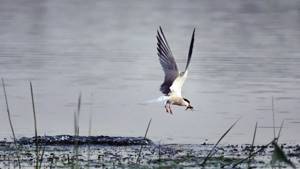
Even on the coldest autumn days, it makes sense to try to find places with warm water, where a wide variety of fish will rush to warm up and say goodbye to the past summer. And pike perch is no exception to the rule. Where to catch pike perch in the fall?
If there is a pipe on a reservoir from which warm water flows into it, then that is where you should look for fish. If the pipe is not visible, then you can stay close to grooves and channels, the water from which can raise the temperature of the coastal waters by several degrees.
Also, don’t discount the seagulls that will circle over the accumulations of fish gathered in places with warm water. You can fish here with all kinds of bait - both artificial and animal.
And remember that fishing for pike perch in the fall is most effective until November, and in the northern regions until the end of September. Don’t miss the moment of the autumn zhora, because next time you will only be able to catch pike perch well from the ice, or you will have to wait for the new season of open water.
How to catch pike perch for beginner anglers:
